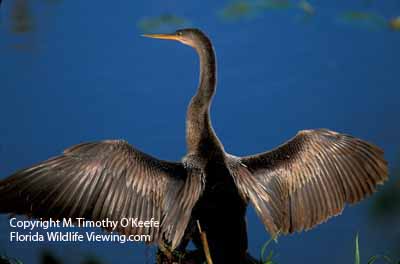Essentials
Home
Where to Go
When to Go
Animal Facts
Photo Gallery
Photo Tips
Kids' Corner
______________
Activities
Florida Birding
Birding Optics
Florida Camping
Kayaking
Nature Festivals
Florida Hiking
Nature Webcams
______________
Florida Travel
Florida Ecotourism
Travel Insurance
Florida Maps
Florida Weather
___________
About Us
Disclaimer
Copyright Notice
Site Search
|
|
Everglades Birding Hotspots

Anhinga, or water turkey, drying its wings.
Birding in the Florida Everglades is some of the best where you might see as many as 300 bird species.
The best birding season is from December to March.
That's the winter dry season when birdlife concentrates mostly
around the permanent bodies of water, which makes them quite easy to
observe. This is by far the best time of year for birding. Mosquitoes
are at their least bothersome, then, too.
Royal Palm Hammock is on the left, just2 miles from the entrance.
The half-mile longAnhinga Trail, the park's single most popular trail,
is named for one of Florida 's most distinctive birds.
The anhinga is also called the water turkey and snake bird,
since it swims almost totally submerged with only its snaky-looking
long neck and head above water. It captures food by diving underwater
and spearing fish with its beak. The anhinga is the bird frequently
spotted perched on a branch with its wings spread like it's in a state
of alarm. The bird is actually drying its feathers. The anhinga lacks
the oil glands needed to keep its plumage dry. If the anhinga didn't
drip-dry itself regularly, it would become so water-logged it would
sink.
Follow
the paved trail to a boardwalk that penetrates a sawgrass prairie. Along
the way look for sora, smooth-billed ani, least bittern and great white
heron
By February the birds should be concentrating around places
like Paurotis Pond (named for the paurotis palms) and
Nine-Mile Pond . Both are good sites for short-tailed
hawks, osprey, herons, bald eagles and what many consider to be the
emblematic bird of the Everglades --the roseate spoonbill. If you miss
spotting a spoonbill here, look again at Mrazek Pond
near Flamingo.
Around the ponds, both migratory and the smaller resident cormorants, Caspian
terns, mottled ducks and swallow-tailed kites may also be present during
the day; look for limpkins and white-crowned pigeons early and late.
Waterfowl
have always been particularly fond of West Lake: American
widgeon, ruddy, pintail, shoveler, scaup (lesser and ring-necked) and
teal (green and blue-winged). The white-crowned pigeon is often sighted
over the lake late in the day. Take the boardwalk along Mangrove Trail
for an incredible concentration of American coots. (This lake is also
a rare opportunity to sight the almost extinct American crocodile.)
When
water levels are low, Mrazek Pond is one of the best
places in the park for bird photography. The place is crowded with many
different species. Because of its easy access, the flocks of birders
can make it difficult to see the birds.
Stretch your legs again at the two-mile long Bear Lake Trail. It passes through tropical woodland where you may find white-crowned pigeons and numerous landbirds.
Unfortunately, the flamingoes are long gone from the small fishing of Flamingo, the gateway to Florida Bay and its mud flats.
But keep an eye out for shorebirds, sandpipers, ospreys, egrets, pelicans and bald eagles in this area.
Everglades Facts: Over
a million people a year visit Everglades National Park, the
second largest national park in the contiguous United States (after
Yellowstone ). The main park entrance is about an hour south of Miami
near Homestead. Take the Florida Turnpike (toll road)
from Miami to Homestead. The Everglades is about another 20 minutes
away. Website
The park's richness is mind-boggling: 2,000 species of plants,
51 types of reptiles, 17 assorted amphibians, 40 different mammals and
an assortment of 347 avians.
To
Florida Birding Homepage
To Everglades Homepage
|
|

